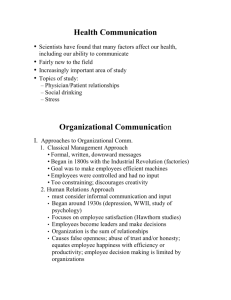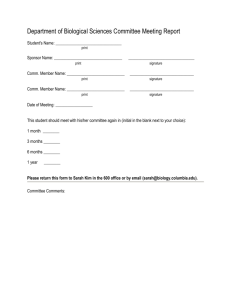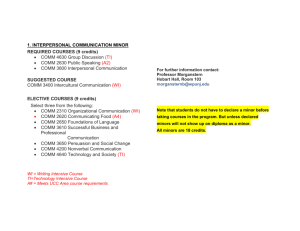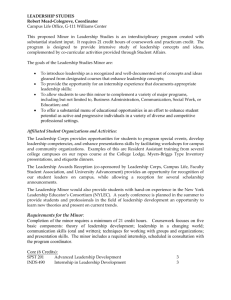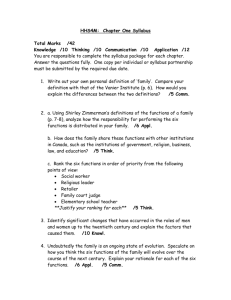Human Communication in Information Agencies
advertisement
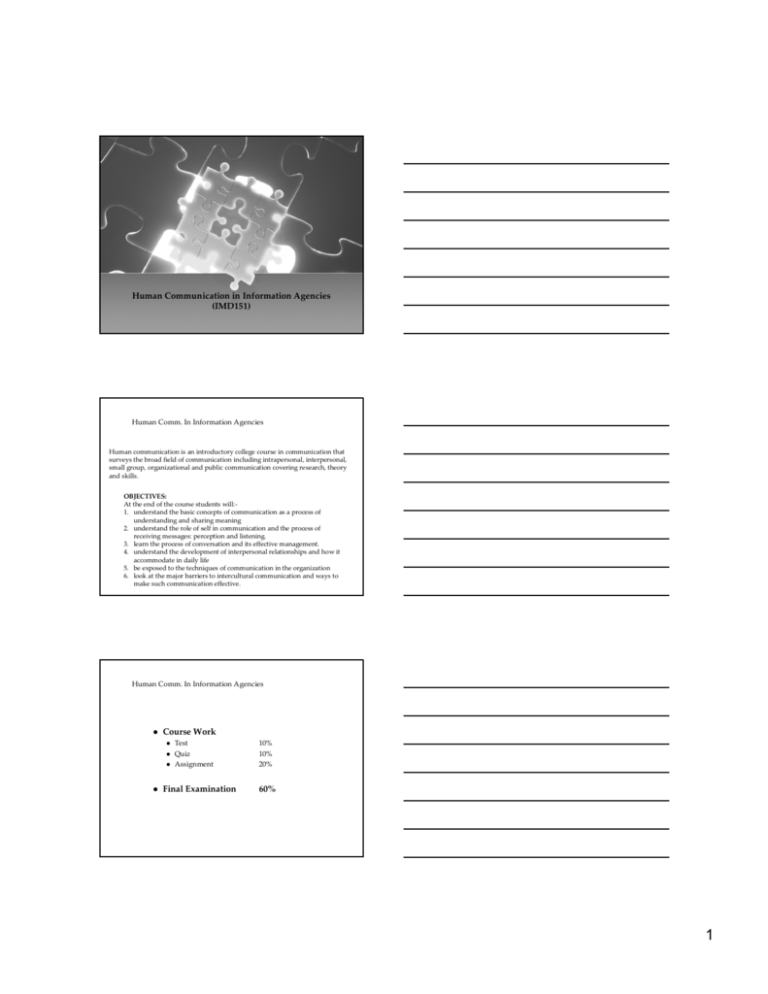
Human Communication in Information Agencies (IMD151) Human Comm. In Information Agencies Human communication is an introductory college course in communication that surveys the broad field of communication including intrapersonal, interpersonal, small group, organizational and public communication covering research, theory and skills. OBJECTIVES: At the end of the course students will:1. understand the basic concepts of communication as a process of understanding and sharing meaning 2. understand the role of self in communication and the process of receiving messages: perception and listening. 3. learn the process of conversation and its effective management. 4. understand the development of interpersonal relationships and how it accommodate in daily life 5. be exposed to the techniques of communication in the organization 6. look at the major barriers to intercultural communication and ways to make such communication effective. Human Comm. In Information Agencies Course Work Test Quiz Assignment Final Examination 10% 10% 20% 60% 1 Human Comm. In Information Agencies 1. DeVito, Joseph A. (2005). Essentials of Human Communication. 5th ed. New York: Longman. 2. DeVito, Joseph A. (2002). Essentials of Human Communication. 4th ed. New York: Longman. 3. Pearson, Judy C. and Paul E. Nelson (2000). An Introduction to Human Communication: Understanding and Sharing. 8th ed. Boston: McGraw Hill. 4. DeVito, Joseph A. (1997). Human communication: the basic course. 8th ed. New York: Longman. 5. Leathers, Dale G. (1992). Successful non verbal communication: principles and applications. London: Macmillan. 6. Little John W. (1993). Human communication theories. New York: Wardsworth. 7. Myers, G.E. and Michele Tolela Myers (1992). The dynamics of human communication: a laboratory approach. 6th ed.London: McGraw-Hill, Inc. 8. Tubbs, S. and Moss, Sylvia (1987). Human communication. London: Random, Inc. Human Communication in Information Agencies (IMD151) Theories in Comm. 1. Linear: speaker spoke and listener listened 2. Interactional: speaker & listener take turn/ exchanging turn at speaking & listening 3. Transactional: each person serves simultaneously as speaker and listener 2 Areas of Communication 1. Intrapersonal : communication with oneself 2. Interpersonal : communication between two person 3. Small Group : comm. within a small group of people 4. Public : communication of speaker to audience Model of Communication Communication Context Messages/channels/ feedbacks Sources Receiver Sources noise Receiver Messages/channels/ feedbacks Comm. Context (factors influences what & how you say) 1. Physical – the tangible and concrete environment 2. Cultural – the lifestyle, beliefs, values, ways of behaving and communicating 3. Social-psychological – the status relationships among participants, the culture rules of the society, the formality & informality of the situation 4. Temporal – the position in which a message fits into a sequence of events 3 Model Communication 1. Source - the person who send the message 2. Receiver - the person who receives the messages 3. Encoding & Decoding the act of sending message the act of receiving message Model Communication 4. Messages may be sent and received through any combination of sensory organs or any forms of messages * Metamessages – message that refer to other message * Feedback – message or information that is sent back to the source * Feedforward – message that preface other messages Model Communication 5. Noise - anything that distorts the messages * Physical - interferes with the physical transmission of signal or message * Physiological - Physical barrier within the speaker or listener * Psychological - cognitive or mental interference * Semantic - receive diff. meaning 4 Model Communication 6. Channel - the medium through which messages are sent 7. Effects - reaction or responses Principles of Communication 1. Comm. is a process of adjustment. - comm. Competence is being able to identify the other person’s signals and understand how they are used and what they mean. 2. Comm. Accommodation – speaker will adjust their speaking style to gain social approval and comm. efficiency 3. Comm. Is a package of signals - made up from verbal or non verbal signals. Principles of Communication 4. Comm. Involves content and relationship dimensions. - must be able to distinguish between content and relationship dimensions of communication 5. Comm. Sequences are punctuated – individuals divide the comm. sequences into stimuli and responses differently. 6. Comm. Is purposeful 7. Comm. is inevitable, irreversible and unrepeatable 8. Comm. Is ambiguous 5 6
